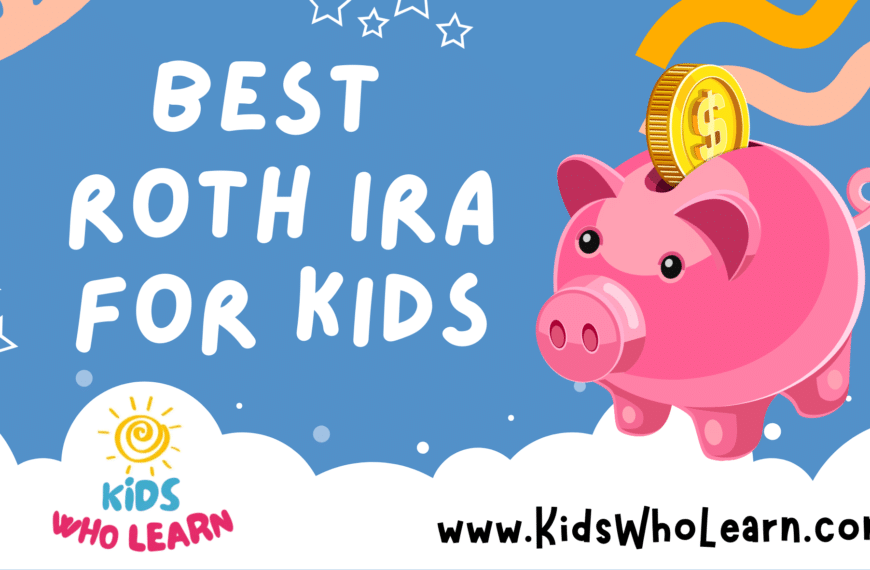Saving money is an essential life skill that everyone should learn, and it’s never too early to start teaching kids about it. By instilling good money habits in your children from a young age, you can help them develop a healthy relationship with money that will benefit them throughout their lives. But what is the best way to save money for kids?
There are many different approaches to saving money for kids, and what works best for one family may not work for another. However, there are some general principles that can help guide your approach. In this article, we’ll explore some of the best ways to save money for kids, including setting up a savings account, teaching kids about budgeting, using technology to encourage saving, and more. Whether you’re a parent, grandparent, or caregiver, you’ll find plenty of practical tips and advice to help you get started.
Key Takeaways
- Teaching kids about the importance of saving money from a young age can help them develop good money habits that will benefit them throughout their lives.
- Setting up a savings account for kids is a great way to help them save money and learn about the basics of banking.
- Using technology, allowances, and rewards can be effective tools for encouraging kids to save money and develop good money habits.
Understanding the Importance of Saving Money
Saving money is an essential life skill that everyone should learn. It is especially important for kids as it can set them up for financial success in the future. In this section, we will discuss the value of financial literacy and the long-term benefits of saving money.
Value of Financial Literacy
Financial literacy is the knowledge and skills required to make informed and effective decisions about money. It is an essential life skill that can help kids make sound financial decisions in the future. By teaching kids about savings, budgeting, and investing, you are helping them develop financial literacy skills that will serve them well throughout their lives.
One way to teach kids about financial literacy is to involve them in the family’s financial decisions. For example, you can take them grocery shopping and show them how to compare prices, use coupons, and make a budget. You can also involve them in household budgeting and show them how to save money by cutting back on unnecessary expenses.
Long-term Benefits
Saving money has many long-term benefits that can help kids achieve their financial goals. By saving money, kids can build up an emergency fund, save for a big purchase, or even invest in the stock market. Here are some of the long-term benefits of saving money:
- Financial security: By building up an emergency fund, kids can protect themselves from unexpected expenses and financial emergencies.
- Achieving financial goals: By saving money, kids can work towards achieving their financial goals, such as buying a car, going to college, or starting a business.
- Building wealth: By investing in the stock market, kids can build wealth over time and achieve financial independence.
In conclusion, teaching kids about the importance of saving money is an essential life skill that can set them up for financial success in the future. By developing financial literacy skills and saving money, kids can achieve their financial goals and build wealth over time.
Setting Up a Savings Account for Kids
When it comes to saving money for your kids, setting up a savings account can be a great way to teach them about financial responsibility and help them build a nest egg for the future. Here are some things to keep in mind when setting up a savings account for your child:
Choosing the Right Bank
When choosing a bank for your child’s savings account, it’s important to consider factors like fees, interest rates, and convenience. Look for a bank that offers low or no fees for kids’ accounts, as well as a competitive interest rate that will help their money grow over time. You may also want to consider the bank’s location and accessibility, as well as any additional features or perks they offer for young savers.
Understanding Interest Rates
Interest rates can have a big impact on your child’s savings over time, so it’s important to understand how they work and how they can affect your account. Generally, the higher the interest rate, the more your money will grow over time. However, it’s important to note that interest rates can fluctuate based on a variety of factors, so it’s important to keep an eye on your account and make sure you’re getting the best possible rate for your child’s savings.
Overall, setting up a savings account for your child can be a great way to help them learn about money management and build a strong financial foundation for the future. Just be sure to do your research and choose the right bank and account type to meet your family’s needs.
Teaching Kids About Budgeting
Teaching kids about budgeting is an excellent way to help them develop good financial habits that will last a lifetime. By teaching them how to budget, you can help them learn how to manage their money responsibly and avoid the pitfalls of overspending.
Making Saving Fun
One of the best ways to teach kids about budgeting is to make saving fun. Encourage your kids to set saving goals for themselves, such as saving for a new toy or a special outing. You can also use games and activities to help them learn about budgeting. For example, you could create a budgeting game where your kids have to allocate their allowance to different categories, such as savings, spending, and giving.
Involving Kids in Financial Decisions
Another way to teach kids about budgeting is to involve them in financial decisions. This can help them learn about the value of money and the importance of making informed decisions. For example, you could involve your kids in deciding how to spend the family’s entertainment budget. This could include deciding whether to go to the movies or to a theme park, and how much to spend on each activity.
By teaching your kids about budgeting, you can help them develop the skills they need to manage their money responsibly. By making saving fun and involving them in financial decisions, you can help them learn about the value of money and the importance of making informed decisions.
Using Technology to Encourage Saving
Teaching kids about saving money can be challenging, but technology can make it easier and more fun. Here are two ways you can use technology to encourage your kids to save:
Educational Apps
There are many educational apps available that can help teach kids about money and saving. Here are a few examples:
- PiggyBot is a free app that allows kids to set savings goals and track their progress. It also has a feature that allows parents to transfer money to their child’s account.
- Bankaroo is a virtual bank for kids that allows them to manage their money and learn about saving, spending, and budgeting. It also has a parent portal that allows parents to monitor their child’s account.
Online Savings Tools
There are also many online savings tools that can help kids save money. Here are a few examples:
- SmartyPig is an online savings account that allows kids to set savings goals and earn interest on their savings. It also has a feature that allows parents to contribute to their child’s account.
- Acorns Early is a savings and investment app for kids that allows them to invest in a diversified portfolio of ETFs. It also has a feature that allows parents to monitor their child’s account.
Using technology to teach kids about saving can be a fun and effective way to help them develop good money habits. By using educational apps and online savings tools, you can make saving money a part of your child’s daily routine.
Implementing Allowances and Rewards
When it comes to teaching kids about money, allowances and rewards are a great way to start. Here are some tips for implementing these strategies effectively.
Deciding on Allowance Amount
Deciding on the right allowance amount can be tricky. You want to give your child enough money to be able to save and spend, but not so much that they become entitled or don’t learn the value of money. A good rule of thumb is to give your child an allowance that is equal to their age. For example, a 10-year-old would receive $10 per week.
However, every family is different, and what works for one child may not work for another. It’s important to consider your family’s financial situation and your child’s needs and responsibilities when deciding on an allowance amount. You may also want to consider tying allowance to chores or other responsibilities.
Rewarding Saving Behaviours
In addition to giving your child an allowance, you can also reward them for saving their money. This can help encourage good saving habits and teach your child the value of delayed gratification. Here are some ways you can reward your child for saving:
- Match their savings: Offer to match a percentage of the money they save each week.
- Bonus for reaching goals: Set savings goals with your child and offer a bonus when they reach them.
- Prizes for milestones: Offer small prizes or treats when your child reaches certain savings milestones.
By implementing allowances and rewards, you can help your child learn important money management skills and develop good saving habits that will benefit them for years to come.
Planning for the Future
When it comes to saving money for your kids, it’s important to have a plan for the future. Here are some tips to help you get started.
Education Funds
One of the best ways to save for your child’s education is to start early. Consider opening a 529 plan, which is a tax-advantaged savings plan designed specifically for education expenses. These plans can be used for tuition, room and board, and other qualified expenses.
Another option is a Coverdell Education Savings Account (ESA), which allows you to save up to $2,000 per year per child for education expenses. These accounts offer tax-free growth and withdrawals for qualified expenses.
Investment Options for Kids
In addition to education funds, it’s also important to consider investing for your child’s future. One option is a custodial account, which is a type of investment account that allows parents to invest money for their child’s benefit. These accounts can be used for any purpose, such as saving for a down payment on a house or starting a business.
Another option is a Roth IRA, which is a retirement account that allows parents to save for their child’s retirement. Contributions are made with after-tax dollars, but earnings grow tax-free and withdrawals are tax-free as well. This can be a great option for parents who want to give their child a head start on retirement savings.
Overall, planning for your child’s future can be a daunting task, but with a little bit of effort and the right strategy, you can help set them up for success. By starting early and exploring your options, you can make sure that your child has the financial resources they need to achieve their goals.
Frequently Asked Questions
What are some good investment options for my child’s future?
Investing in your child’s future is a great way to ensure they have a financially stable future. Some good investment options for your child’s future include stocks, mutual funds, and bonds. You can also consider investing in a 529 college savings plan which offers tax benefits.
How much should I save for my child’s future?
The amount you should save for your child’s future depends on your financial situation, your child’s needs, and your long-term goals. A good rule of thumb is to save at least 10% of your income for your child’s future. You can also use online calculators to determine how much you should save based on your child’s age and your investment goals.
What are the benefits of a 529 plan for my child?
A 529 college savings plan is a tax-advantaged investment account designed to save for future education expenses. The benefits of a 529 plan include tax-free growth, tax-free withdrawals for qualified education expenses, and potential state tax deductions. Additionally, 529 plans offer flexibility in terms of investment options and contribution limits.
What are some savings account options for kids?
There are many savings account options for kids, including traditional savings accounts, custodial accounts, and youth savings accounts. These accounts typically offer competitive interest rates and low fees. Some banks also offer rewards programs and other incentives to encourage kids to save.
What are some creative ways for kids to save money?
Encouraging kids to save money can be challenging, but there are many creative ways to make saving fun. You can create a savings challenge, offer rewards for reaching savings goals, or encourage kids to save spare change. Additionally, you can teach your child about budgeting and the importance of saving for long-term goals.
How can I teach my child to save money from a young age?
Teaching your child to save money from a young age is important for their financial future. You can start by setting a good example and encouraging your child to save a portion of their allowance or earnings. You can also involve your child in family budgeting and teach them about the importance of setting financial goals. Additionally, you can use games and other fun activities to make learning about money and saving more engaging.







